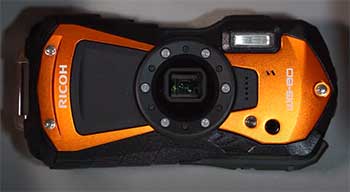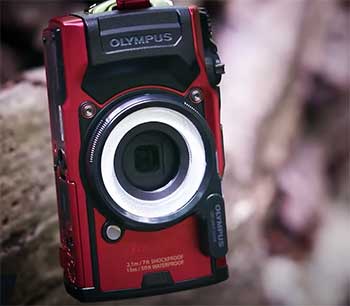Adventurers and outdoor enthusiasts need a camera that can withstand the elements. The Ricoh WG-80 and Olympus TG-6 are two of the best waterproof point-and-shoot cameras on the market. But which is better for your needs?
In this in-depth comparison, we’ll examine the design, image quality, features, performance, and price of the Ricoh WG-80 and Olympus TG-6. Read on to see which rugged compact camera emerges as the victor.
A Brief Comparison Table
| Feature | Ricoh WG-80 | Olympus TG-6 |
| Sensor Resolution | 16MP | 20MP |
| Max Aperture | f/3.5 | f/2.0 |
| Optical Zoom | 5x | 4x |
| Image Stabilization | 3 stops | 4 stops |
| Video Resolution | 1080p | 4K |
| GPS | No | Yes |
| Battery Life | 300 shots | 340 shots |
| Price | $280-$330 | $379-$450 |
Design And Build Quality
First let’s examine the physical build and durability of each camera:

- Waterproof Rating – The WG-80 and TG-6 are both waterproof up to 50 feet without a separate housing. Perfect for snorkeling and shallow diving.
- Freezeproof – They can both withstand 14°F temperature dips. Great for skiing and cold weather adventures.
- Crushproof – Each camera can withstand over 200 pounds of force. No worries about damage from drops or bumps.
- Dustproof – Their airtight seals protect against fine debris entering the body. Ideal for dusty trails and sandy beaches.
While the durability ratings are similar, the TG-6 is slightly more compact at 4.5 x 2.6 x 1.3 inches versus 4.8 x 2.5 x 1.2 inches on the WG-80. But both will fit comfortably in your pocket.
Image Quality And Photo Features
When it comes to image quality from the sensor and lens, there are some key differences:
- Sensor – The TG-6 has a higher resolution 20MP sensor compared to 16MP on the WG-80. This allows more detailed enlargements.
- Lens Aperture – With a max aperture of F2.0, the Olympus can gather more light for better low light performance. The Ricoh maxes out at F3.5.
- Optical Zoom – The WG-80 has 5x optical zoom reaching from 28-140mm. The TG-6 is a bit more limited at 4x optical zoom (25-100mm).
- Image Stabilization – Both feature sensor shift image stabilization to reduce blur from shaky shots. The TG-6 is rated at 4 stops versus 3 stops for the WG-80.
- Macro Mode – The TG-6 excels here with focus possible from just 1cm away. The WG-80 requires a minimum 5cm focus distance.
The TG-6 definitely beats the WG-80 for still image quality and close-up shots. But the Ricoh isn’t too far behind.
Also Read: Choose Between Spot AI And Verkada.
Video Recording Capabilities
For video, the Ricoh WG-80 can record 1080p full HD footage up to 30 fps. The Olympus TG-6 ups the video resolution to 4K at 30 fps. Slow motion options are 720p video at 120 fps on the WG-80 versus 1080p 120 fps on the TG-6. So advantage Olympus here as well.
Low Light Performance
With a wider max aperture and higher ISO options up to 12,800, the TG-6 excels in dim lighting scenarios. Its noise reduction is also better at preserving details at high ISOs. The WG-80 peaks at ISO 6400 and exhibits more visible noise at higher sensitivities.
Shooting Modes, Features And Extras
Both cameras offer a range of useful shooting modes and bonus features:

- Scene Modes – Standard presets like portrait, landscape, night, and macro modes. The Olympus also adds underwater modes.
- Manual Exposure – Priority and full manual modes provide control over shutter speed, aperture, and ISO.
- WB Adjustment – White balance can be manually tuned or set to presets like sunlight, clouds, shade etc.
- Panorama – Automatically stitch together panoramic images.
- Timelapse – Create timelapse movies right in camera.
- HDR – Combine multiple exposures for greater dynamic range.
- GPS – The Olympus TG-6 has a built-in GPS tracker to geotag images. The WG-80 does not.
- Compass – Useful for navigation and determining shooting direction. Included on the TG-6.
- Underwater Modes – Special scene presets for underwater photography on the Olympus.
The TG-6 definitely provides more bonus features tailored for outdoor and adventure use.
Display And Menu System
Both cameras have 3 inch LCDs with similar 230k dot resolutions. The key difference is the TG-6 includes a quick menu button for frequently adjusted settings. Its menus are generally easier to navigate compared to the more cluttered Ricoh setup.
Battery Life
With typical use you can expect around 250-300 shots per charge from either model. The TG-6 may have a slight edge in shooting longer videos due to the larger LI-92B battery compared to the smaller DB-65 used in the WG-80.
But neither will rival an DSLR or mirrorless camera in battery performance. Carrying a spare battery is recommended for long excursions.
Price Comparison
As a newer model with superior imaging capabilities, the Olympus TG-6 commands a higher price:
- Ricoh WG-80 – Retails around $280-330.
- Olympus TG-6 – Approximately $379-450.
But it’s well worth paying the premium if you want maximum image quality in a rugged point-and-shoot.
Also watch the video about Olympus TG-6!
Frequently Asked Questions (FAQ)
Yes, the Ricoh WG-80 does have built-in WiFi. It can connect directly to smartphones or tablets for wireless transfer of images and remote control functionality.
The newest Olympus TG-6 is the best in their current rugged camera lineup. It has the most advanced features and highest image quality. Some other top options are the TG-5 and TG-4. Avoid older models like the TG-1 or TG-2.
Yes, the TG-6 features sensor shift image stabilization. Olympus claims up to 4 stops of shake reduction with IS active. This helps reduce blur in low light shots and while zooming.
The shutter speed on the TG-6 can be set as fast as 1/2000s or as slow as 4 seconds. Using very slow shutter speeds risks blurry images unless the camera is stabilized. But the built-in IS allows reasonable sharpness down to 1-2 second exposures.
Also Read: Should You Buy Ruko F11 Gim Or Ruko F11 Gim2?
Our Recommendation
In conclusion, the Olympus TG-6 is the superior rugged camera for image quality and features, albeit at a higher price. But the Ricoh WG-80 still delivers good performance for a budget-friendly price, making it a great value choice.
For superior photo and video quality in tough conditions, the Olympus TG-6 is the clear winner in our comparison. The larger sensor, faster lens, RAW capture, 4K video, and bonus features like GPS make it the better choice for demanding users. It’s the clear leader in the waterproof point-and-shoot category.
But the Ricoh WG-80 remains a good value option. While the TG-6 wins on performance and IQ, the WG-80 still produces nice looking images and 1080p video at a lower price point. It’s a good choice for those on a tight budget.
So choose the TG-6 if you want the absolute best quality without compromise. But don’t overlook the WG-80 for an affordable alternative that still delivers impressive rugged performance. Either way, your photography will thrive outdoors rain or shine.